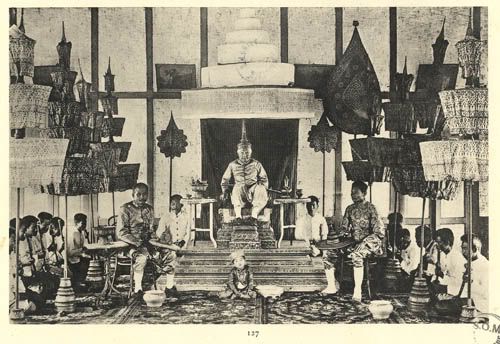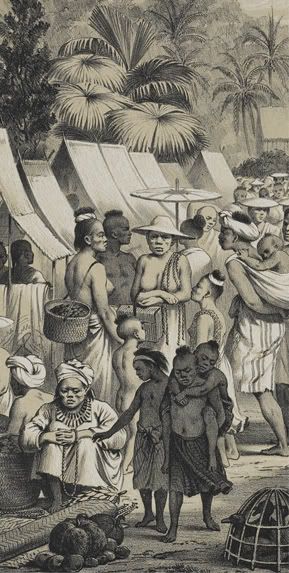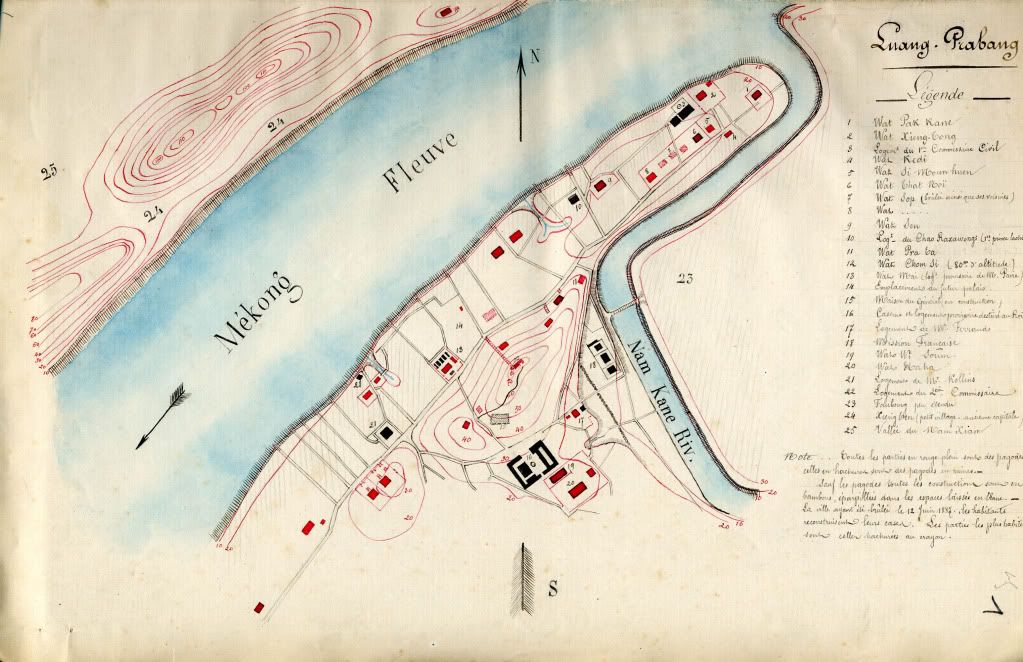
A big thanks to everyone who has chimed in about Lao Steampunk! A few thoughts came up about plausible Lao Steampunk and how to develop a good story in such a setting.
Because so much of the history remains contested, I add my customary recommendation to do as much research as possible on the real lives and times of the Lao and others in this era. Historical documents should be considered for their respective bias. It should go without saying that their bias is extremely heavy by our standards today.

Because Steampunk often relies on clockworks, spring-driven and steam-powered devices, it may be useful to bear in mind that the first known mechanical clock to arrive in China was introduced on December 27th, 1582.
Lan Xang splits into several kingdoms around 1707. This could provide a plausible opening between 1583-1707 or approximately 124 years in which someone from Lan Xang could have made an effort to acquire and study these mechanical devices that drives most Steampunk technology. Historically mechanical clocks in Asia were considered novelties and not applied towards scientific or utilitarian purposes for many years.
Technologies of particular interest are those connected to transport. A good majority of travel is conducted by rivers, especially along the Mekong. Railroads were difficult to introduce to the region until very late in the Victorian Era, with the first notable one connecting Bangkok to Ayutthaya following a year of construction in 1892. But what might have happened if more railways or steamships had been available during this time or earlier?
Tin, copper, and gold in addition to teak hardwood and bamboo are key natural resources Steampunk technology would be made from in Laos. Gypsum is also an abundant resource here.

The most likely setting for Lao Steampunk stories would be in or near Luang Prabang, the royal capital of Lan Xang, and comparatively easier for writers to research compared to the limited, almost non-existent historical records that survived for Vieng Chan and Champassak. However, aspiring authors may find this lack of documentation actually eases the writing process by allowing them to fill in the blanks with their own alternate history with reduced fear of contradiction.
King Oun Kham ruled Luang Prabang from 1872-1887 and 1889-1895 while the French were a major presence there. His predecessors included King Anourathurath from 1792-1819, and King Chantharath who reigned from 1850-1868. They were all particularly known for overseeing the construction of Buddhist monasteries in the realm of Luang Prabang, with over 65 wats recorded before the invasion of the Black Flag bandits in 1887. After 1887, most of these wat Lao had been destroyed. Just over half of these complexes were rebuilt and restored in the years afterwards.

King Mongkut or Rama IV ruled Siam from 1851-1868 and dealt with Western expansionism, but embraced many of the innovations and technologies from Europe. For this, he became known as the "Father of Science and Technology" in Siam. Around 1852, Rama IV hired western mercenaries to train his army in European combat techniques. He was succeeded by his son Chulalongkorn or Rama V, who would rule from 1868-1910. One of the great challenges of Rama V's reign was enacting policies that would enable them to resist colonization. The Lao kingdoms and Siam came into conflict during the early 1800s which left a significant amount of the Lao infrastructure destroyed or heavily damaged, particularly in Vientiane. This is still something of a touchy subject, and I would recommend examining the subject sensitively.
Steampunk often addresses secret societies and a criminal underworld. Lao society from this era does not actively note secret societies or criminal underworld organizations similar to those in Europe or the Yakuza or Triads. But this does not mean that a writer could not speculate how a more formal group could exist.
Writers looking for antagonists may wish to note the Haw Wars, particularly the Black Flag Bandits following the disbanding of their army in 1885. Led by Liu Yongfu, the Black Flag Army harassed the French between 1857-1887. Most were ethnic Zhuang bandits from China who had the support of Annam and Chinese authorities in trying to drive the French from the Southeast Asia.

Lao Steampunk can tell many interesting stories regarding many of the different unexplored, undiscovered cave complexes that abound in the country at this time.
Take for example the recent discovery of the Xe Fang Bai river cave in central Laos. Many adventures could begin here or similar cave complexes, including homages to 'Journey to the Center of the Earth' or 'The Lost World':

Lan Xang splits into several kingdoms around 1707. This could provide a plausible opening between 1583-1707 or approximately 124 years in which someone from Lan Xang could have made an effort to acquire and study these mechanical devices that drives most Steampunk technology. Historically mechanical clocks in Asia were considered novelties and not applied towards scientific or utilitarian purposes for many years.
Technologies of particular interest are those connected to transport. A good majority of travel is conducted by rivers, especially along the Mekong. Railroads were difficult to introduce to the region until very late in the Victorian Era, with the first notable one connecting Bangkok to Ayutthaya following a year of construction in 1892. But what might have happened if more railways or steamships had been available during this time or earlier?
Tin, copper, and gold in addition to teak hardwood and bamboo are key natural resources Steampunk technology would be made from in Laos. Gypsum is also an abundant resource here.

The most likely setting for Lao Steampunk stories would be in or near Luang Prabang, the royal capital of Lan Xang, and comparatively easier for writers to research compared to the limited, almost non-existent historical records that survived for Vieng Chan and Champassak. However, aspiring authors may find this lack of documentation actually eases the writing process by allowing them to fill in the blanks with their own alternate history with reduced fear of contradiction.
King Oun Kham ruled Luang Prabang from 1872-1887 and 1889-1895 while the French were a major presence there. His predecessors included King Anourathurath from 1792-1819, and King Chantharath who reigned from 1850-1868. They were all particularly known for overseeing the construction of Buddhist monasteries in the realm of Luang Prabang, with over 65 wats recorded before the invasion of the Black Flag bandits in 1887. After 1887, most of these wat Lao had been destroyed. Just over half of these complexes were rebuilt and restored in the years afterwards.

Most Lao Steampunk stories would find a point of inspiration in the complicated politics and beliefs of the era, including debates to embrace new technologies and how they should address Western expansionism.
Among the schools of thought influencing these societies are Buddhist principles, notably the 5 precepts, and Lao folk law. Many of the ethnic minorities at this time practice forms of animism and shamanism. Confucian ideas came from the north from the Yunnan province of China, and to a lesser extent Taoism. The influence of Hinduism should be noted. These beliefs are relevant because Steampunk stories often focus on class divide and the violation of social mores through a Victorian monotheistic lens. Stories set in Laos could explore the punk aspect of the genre by having protagonists wrestle with Southeast Asian principles of decorum, which are not fully interchangeable with East Asian and Western mores. How might a strong belief in reincarnation, karma, and dharma drive Lao Steampunks' interaction with technology and their society?
A Lao Steampunk story would take into consideration the international interests present at the time. There is definite engagement and interaction with their geographic neighbors, including China, Annam (Vietnam), Cambodia, Burma, the Shan States and Siam (Thailand), as well as the kingdoms formed from the split of Lan Xang. Much of this century is marked by conflict and violence nearby and in the three kingdoms that would one day become Laos.

During the Victorian Era the British are relative latecomers but establish a significant influence in Siam, the Shan states and Burma. Europeans from Portugal, the Netherlands, as well as the Dutch and Spanish arrived much earlier, setting up missions, colonies and trading stations to the south. The French begin significantly exerting military force around 1883 using the Tonkin Expeditionary Force in northern Annam, but many missionaries and explorers had traveled there earlier.

Among the schools of thought influencing these societies are Buddhist principles, notably the 5 precepts, and Lao folk law. Many of the ethnic minorities at this time practice forms of animism and shamanism. Confucian ideas came from the north from the Yunnan province of China, and to a lesser extent Taoism. The influence of Hinduism should be noted. These beliefs are relevant because Steampunk stories often focus on class divide and the violation of social mores through a Victorian monotheistic lens. Stories set in Laos could explore the punk aspect of the genre by having protagonists wrestle with Southeast Asian principles of decorum, which are not fully interchangeable with East Asian and Western mores. How might a strong belief in reincarnation, karma, and dharma drive Lao Steampunks' interaction with technology and their society?
A Lao Steampunk story would take into consideration the international interests present at the time. There is definite engagement and interaction with their geographic neighbors, including China, Annam (Vietnam), Cambodia, Burma, the Shan States and Siam (Thailand), as well as the kingdoms formed from the split of Lan Xang. Much of this century is marked by conflict and violence nearby and in the three kingdoms that would one day become Laos.

During the Victorian Era the British are relative latecomers but establish a significant influence in Siam, the Shan states and Burma. Europeans from Portugal, the Netherlands, as well as the Dutch and Spanish arrived much earlier, setting up missions, colonies and trading stations to the south. The French begin significantly exerting military force around 1883 using the Tonkin Expeditionary Force in northern Annam, but many missionaries and explorers had traveled there earlier.

I advise people planning to write a Lao Steampunk story to look at the notes and journey of Auguste Pavie whose missions played a significant role in the relationship of the French to Southeast Asia, particularly Laos and Cambodia.
Pavie took with him as many as 40 scientists, soldiers, artists and diplomats with him to survey the region, building relationships and making notes of it all from a scientific and social perspective. Many of the photos and illustrations for this post come from the Pavie mission. White Lotus Books has a collection of his notes translated into English.


King Mongkut or Rama IV ruled Siam from 1851-1868 and dealt with Western expansionism, but embraced many of the innovations and technologies from Europe. For this, he became known as the "Father of Science and Technology" in Siam. Around 1852, Rama IV hired western mercenaries to train his army in European combat techniques. He was succeeded by his son Chulalongkorn or Rama V, who would rule from 1868-1910. One of the great challenges of Rama V's reign was enacting policies that would enable them to resist colonization. The Lao kingdoms and Siam came into conflict during the early 1800s which left a significant amount of the Lao infrastructure destroyed or heavily damaged, particularly in Vientiane. This is still something of a touchy subject, and I would recommend examining the subject sensitively.
Steampunk often addresses secret societies and a criminal underworld. Lao society from this era does not actively note secret societies or criminal underworld organizations similar to those in Europe or the Yakuza or Triads. But this does not mean that a writer could not speculate how a more formal group could exist.
Writers looking for antagonists may wish to note the Haw Wars, particularly the Black Flag Bandits following the disbanding of their army in 1885. Led by Liu Yongfu, the Black Flag Army harassed the French between 1857-1887. Most were ethnic Zhuang bandits from China who had the support of Annam and Chinese authorities in trying to drive the French from the Southeast Asia.

A Black Flag Soldier, 1885
Lao Steampunk can tell many interesting stories regarding many of the different unexplored, undiscovered cave complexes that abound in the country at this time.
Take for example the recent discovery of the Xe Fang Bai river cave in central Laos. Many adventures could begin here or similar cave complexes, including homages to 'Journey to the Center of the Earth' or 'The Lost World':

Hopefully, this gives you some additional inspiration and energy to explore the fascinating possibilities of Lao Steampunk fiction and alternate history. What are some ways you would approach this genre?
No comments:
Post a Comment